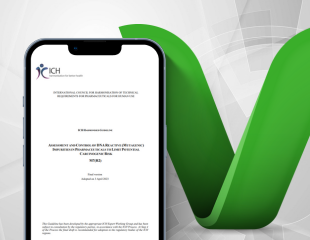Following our recent Lhasa Limited hosted webinar, ICH S1B(R1): industry and regulatory best practice for confident carcinogenicity assessment, attendees had the rare opportunity to engage directly with experts who helped shape the ICH S1B(R1) Addendum.
The ICH S1B(R1) Addendum is a globally recognised guideline that introduces a weight-of-evidence (WoE) approach to assessing the carcinogenic potential of pharmaceuticals. It helps pharmaceutical organisations determine whether a two-year rat carcinogenicity study would provide additional insight into human safety.
In the live Q&A session, Dr Todd Bourcier, Dr Tim McGovern and Dr Ron Steigerwalt, all former ICH S1B Expert Working Group representatives, were joined by Dr Alex Cayley, Principal Scientist at Lhasa Limited, to address audience questions on the practical implementation of WoE approaches, study design considerations, and regulatory perspectives.
Here are some of the highlights and reflections from their discussion.
Encouraging global alignment between regulatory agencies
Question: How is inter-agency alignment handled across the Food and Drug Administration (FDA), European Medicines Agency (EMA) and Pharmaceuticals and Medical Devices Agency (PMDA)?
Todd shared that the early meetings of the ICH implementation working group revealed encouraging levels of consistency:
“We looked at 22 cases reviewed by two or more agencies, and 20 of those reached the same conclusion independently (as of 2024). That was really encouraging. It shows a strong commonality among regulators, though there’s still room to improve alignment between industry and regulators.”
Dr Todd Bourcier
He emphasised that continued dialogue, through webinars like this one, plays a vital role in improving mutual understanding and decision-making consistency.
Considering non-rodent data in the weight of evidence
Question: Should data from non-rodent studies, such as findings of hypertrophy or hyperplasia in other species, be included in the WoE evaluation?
Tim explained that if such data exists, they have value in supporting the overall assessment:
"If you have evidence of potential carcinogenic impact from non-rodent studies, it’s important to include it in the discussion. The focus will still primarily be on the rat data, but non-rodent findings are taken into account as part of the full picture.”
Dr Tim McGovern
Todd added that non-rodent findings often provide valuable insight into human carcinogenic potential, not just whether a two-year rat study adds value:
“If there are findings of concern in non-rodents, say in a nine-month non-human primate (NHP) study, that aren’t observed in rats, that tells us something about human risk potential, even if the rat study wouldn’t necessarily capture it.”
Dr Todd Bourcier
When a mouse study may not add value
Question: If there is strong WoE that rodent studies will not add value, are there any real world examples of justification being applied to not conducting a mouse study?
Todd shared two real-world examples:
“There have been cases where the US FDA agreed that a two-year mouse study would not add further value. In those situations, the compounds were already considered likely human carcinogenic risks based on target biology and other supporting data. Additional rodent studies wouldn’t have changed that conclusion.”
Dr Todd Bourcier
He went on to note that while the addendum primarily focuses on the rat, similar reasoning could apply to the mouse in comparable circumstances.
“In those particular cases,” he said, “the FDA’s view was essentially that if the compound is already a likely human risk, there’s really no need to do a mouse study either.”
Dr Todd Bourcier
Tim added further context:
“The default expectation is usually that a mouse study is conducted. However, if exposure levels in mice are subtherapeutic or pharmacologically inactive, or if a compound presents a clear human risk, regulators may accept that the mouse study wouldn’t add value.”
Dr Tim McGovern
When the rat isn’t relevant, what happens next?
Question: In some programs, where the mouse is selected as the most relevant rodent species and used for general toxicity testing, can a WoE approach also be applied to the value of a two-year mouse carcinogenicity study?
“A ‘mouse-only’ toxicology program falls outside the strict adherence of the addendum addressing the need for a rat study. The approach to carcinogenicity assessment for mouse-only programs instead fall within existing flexibilities of the FDA and other regulatory agencies, and would be addressed on a case-by-case basis.”
Dr Tim McGovern & Dr Todd Bourcier
Ron shared examples from his experience where rat studies were inappropriate:
“We’ve had cases where the rat wasn’t a relevant species. In those instances, we relied on a transgenic mouse study, in addition to the information demonstrating that rats weren’t relevant, but even then, regulators might ask about alternatives, like hamsters. It’s rare, but it happens, so be prepared to justify your reasoning.”
Dr Ron Steigerwalt
He highlighted that regulators may seek alternative species if neither rat nor mouse data are suitable, though practical experience with these models is limited.
Accounting for protein binding in secondary pharmacology
Question: For secondary pharmacology evaluation, should protein binding be considered?
Todd acknowledged that it’s a nuanced issue:
“It can be relevant, particularly when considering exposure margins. If you’re hitting an off-target endpoint that may have carcinogenic relevance, differences in protein binding could factor into how you interpret that risk.”
Dr Todd Bourcier
Tim and Ron expanded on this, noting that free levels are just one part of a complex assessment:
“You have to look at the broader biological context, what happens if that receptor or kinase is activated or inhibited? Free plasma levels alone don’t tell the whole story, as drug distribution varies by compartment, like the brain or liver.”
Dr Tim McGovern & Dr Ron Steigerwalt
The panel noted that this can become complex quickly when accounting for differences in tissue distribution and the relevance of those compartments to carcinogenic potential.
Managing rodent-specific effects that limit lifespan, such as amyloidosis
Question: For a compound inducing early onset of amyloidosis, which has been shown not to be human relevant, but limit the lifespan of mice to less than 6 months. Is there still a chance for waiving two-year rat study after WoE?
Ron advised that it depends on the data available:
“If the rat also experiences reduced lifespan, feasibility becomes the first question. You’d need data to show that the effect is rodent-specific and not human relevant. In some cases, that could support waiving the study, but it really depends on the strength of the overall WoE and the potential impact on the product label.”
Dr Ron Steigerwalt
Concluding thoughts
The Q&A underscored just how nuanced and case-specific the application of the ICH S1B(R1) Addendum can be. Across every topic, whether considering alternative models, interpreting non-rodent data, or navigating inter-agency expectations, the message was clear: flexibility and scientific justification are key.
As the panellists concluded:
The more we use the weight-of-evidence approach, strategically and judiciously, the better we’ll become at applying it.
For those developing or reviewing carcinogenicity assessments, these insights serve as valuable guidance to ensure decisions are both scientifically sound and aligned with current regulatory expectations. If you missed the live webinar session, view the recording here.
Driving confident regulatory and scientific decision-making in carcinogenicity assessment.
If you’d like to learn how our decision support tool Kaptis can support your carcinogenicity assessments, from structuring your WoE evaluation to helping you clearly justify your decision-making, contact our team today.
Last Updated on November 19, 2025 by lhasalimited




